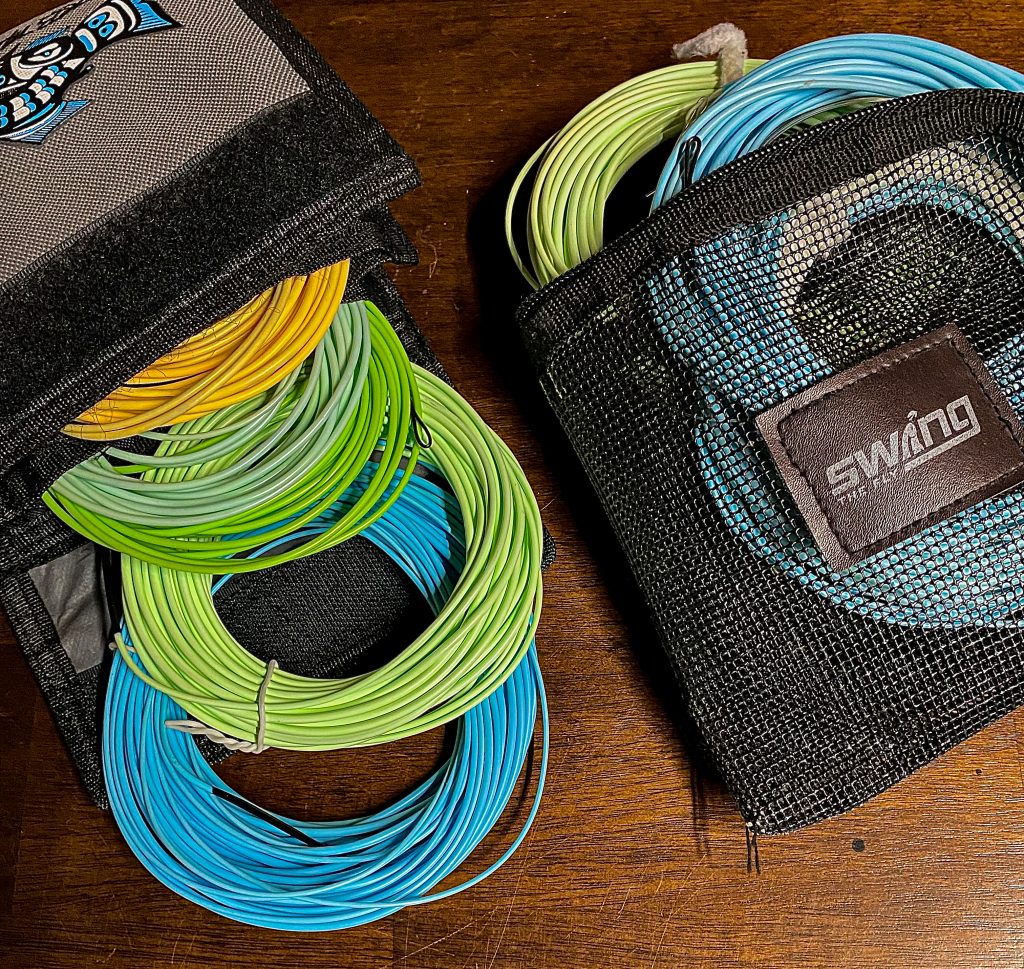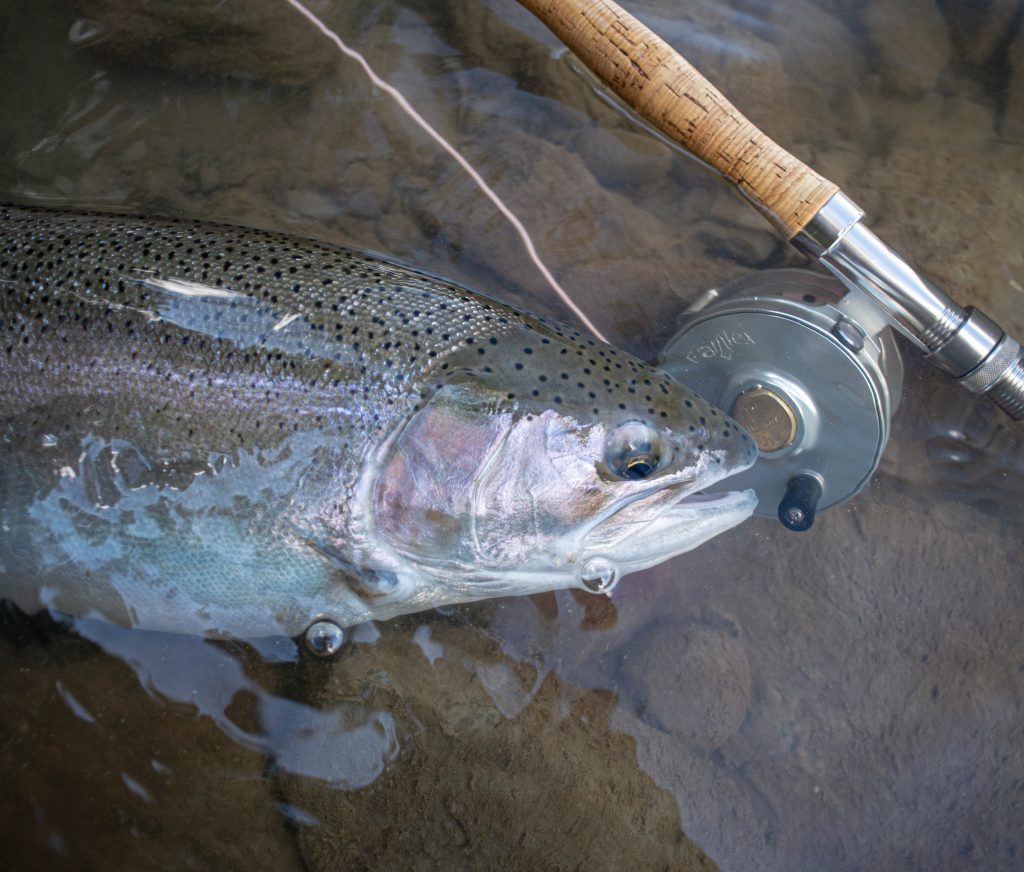Entering into the world of Spey and a swung fly can be daunting. The terminology and various equipment/rigging options act as a deterrent or even barrier for some new anglers beginning their Spey journey. But developing a strong working knowledge of the basics allows for a deeper understanding of Spey fishing while helping new anglers make proper equipment and rigging choices for a given situation.
Let’s begin with rods.
Spey casting is generally associated with two-handed rods. However, all the basic Spey casts can also be made using a single-hand with a rod that is properly rigged for Spey. Rods for Spey casting can be loosely grouped into the following categories:
- Long two-handed rods – I consider two-handers 14 feet or greater to fit into this category. Few rods greater than 16 feet are currently available from rod manufacturers. Long rods are generally stout and match well with large anadromous fish. Long rods also match well with longer head lines and when fishing big water.
- Short / mid-length rod – rod lengths of 11 feet 6 inches up to 14 feet fit into this category. Rods in this range tend to have a lighter feel than longer two-handers and generally match with shorter to mid length head lines and shorter shooting heads. Rods in this length can be used on a wide range of water sizes and types.
- Switch rods – this is a term used loosely to describe shorter, compact rods from 10 up to 11 feet 6 inches with enough of a bottom grip to be cast with two hands. Most are also light enough to be cast and fished with one hand. Switch rods excel on smaller waters and tight casting areas since the shorter head lines typically used with this range of rods result in smaller D loops reducing contact with river side obstructions.
- Trout Spey – rods in this category are generally the same length as a switch rod but are lighter built for lighter heads. Trout Spey matches well to the generally smaller average size of resident trout as compared to migratory fish.
- One-hand Spey – rods designed for one hand Spey are generally light and in the 10 feet to 10 feet 6 inch range. But almost any one-hand rod 9 feet or longer can be used for one hand Spey when rigged with a properly balanced head.

Modern Spey lines are built on the concept of a thicker, heavier head section connected to a thinner level line referred to as running or shooting line. The head is designed to be outside the tip of the rod and the momentum of the head pulls the running or shooting line that has been stripped from the reel to cast significant distances. Heads are commonly connected to the running line with a loop-to-loop connection. This allows for an easy exchange of heads without carrying multiple reels. The running or shooting lines can be a thin coated line similar to the fly line or be constructed from monofilament or braid. There are some lines on the market with an integrated connection between the head and running line. This style of line works best with fishing techniques that require the head of the line to be regularly retrieved inside the tip of the rod. Lines can be loosely grouped into the following categories:
- Long head or belly – generally have a head length of 60 to 65 feet or longer with a long front taper. Long head lines work best on big water with sufficient room for a big D loop and match with longer rods. The longer head requires less stripping of running line before beginning the next cast.
- Mid head or belly – generally have a head length of 50 to 60 feet and match well with rods in the 12 feet 6 inch to 14 feet range. Like a long belly, this style of line typically has a long front taper. It offers some of the advantages of a long belly while being easy to handle in most fishing situations.
- Short head or belly – generally have a head length of 40 to 50 feet and match best with rods 13 feet or under. Shorter heads excel in tighter casting situations where a smaller D loop is preferred.
- Specialty shooting heads – a shooting head is a shorter head that is designed to generate line speed and shoot significant distances. Two styles of shooting heads have become very popular for the relative ease in casting and versatility in presenting a fly.
- Skagit head – is a short head generally 20 to 26 feet in length with shorter versions available for switch and one-hand Spey casting. The short head of a Skagit carries significant mass that can easily handle heavy sink-tips and weighted flies, making it a very versatile fishing tool. Due to the shorter length there is an ease in casting and the standard length heads match best with rods in the 12 to 14 feet range.
- Scandi head – generally with a length of 30 to 40 feet there are some versions available on the market that are somewhat shorter or longer than this range. The Scandi head has a long front taper that can generate significant line speed and cast long distances. The long front taper gives the Scandi a smoother feel than a Skagit head. However, this style of head is limited in the additional weight it can carry in terms of a sink tip or weighted fly and is a good choice when fishing higher in the water column.
- Grain weight – one of the more confusing areas of modern Spey casting is that most lines, particularly Skagit and Scandi heads are denoted and marketed using a grain weight designation. However, many of the longer belly lines still use a line weight designation as do most rods on the market. Some rod manufacturers are adding the grain weight window on the rod as well as the line weight designation. The lower value of the grain weight window generally equates to the recommended Scandi head weight and the higher value relates to a long head. When determining the proper Skagit or Scandi head to match with a rod, the grain weight should only consider the weight of the head and not include the weight of a sink-tip or sinking leader. A quality fly shop can help line up the proper head to a rod. Also, most rod manufactures have line grain weight recommendations for their rods online and there are also charts available that list the most common two-handed rods and the recommended grain weight by head style.

The last step of connection to a fish is the leader. Most modern Spey lines also accommodate the addition of a sinking leader or sink-tip to take the fly down in the water column. Some lines are available that have multiple interchangeable tips that typically include a floater and sink tips with a variety of sink rates.
- Leader – constructed of monofilament or fluorocarbon. For floating heads the leader is typically tapered and the approximate length of the rod. Level leaders are sometimes used for large anadromous fish. For sink-tips or sinking leaders a leader generally 2 to 5 feet in length is added using a loop-to-loop connection. This short leader can be a single diameter or stepped down with a larger diameter at the butt or loop connection.
- Sink-tip – a sinking section of fly line looped to the front end of a head to fish a fly down in the water column. Tips can be grouped into two categories – manufactured tips with welded loops typically tapered with density compensation or multiple densities, and homemade level tips cut to length from sinking material and loops added to each end. Homemade tips are commonly constructed from T material (fly line with a tungsten compound coating.) Tips are available in a variety of sink rates and are typically in the 10- to-15-foot range in length.
- Sinking leader – sometimes referred to as a poly leader, it generally has a nylon core with a coating similar to a fly line and impregnated with weight. A sinking leader is tapered to allow for a smooth turnover and designed with a low diameter to maximize sink rate. Most sinking leaders have welded loops and are available in a range of sink rates and length from 5 to 14 feet.
- Tippet – is the terminal end of the rigging and can be constructed from monofilament or fluorocarbon. On a long leader attached to a floating line or head, the tippet is the last section of lowest diameter material knotted to the fly. While the monofilament or fluorocarbon looped onto a sink-tip or sinking leader is considered a leader it can also be referred to as tippet since it is the connection to the fly. For sink-tip leaders that have two sections, the rear is considered the butt and the front considered the tippet.

